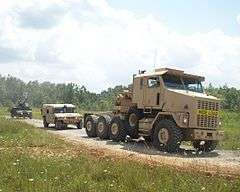All-wheel drive


An all-wheel drive vehicle (AWD vehicle) is one with a powertrain capable of providing power to all its wheels, whether full-time or on-demand.
The most common forms of all-wheel drive are:
- 4×4 (also, four-wheel drive and 4WD)
- Reflecting two axles with both wheels on each capable of being powered.
- 6×6 (also, six-wheel drive and 6WD)
- Reflecting three axles with both wheels on each capable of being powered.
- 8×8 (also, eight-wheel drive and 8WD)
- Reflecting four axles with both wheels on each capable of being powered.
Vehicles may be either part-time all-wheel drive or full-time:
- On-demand (also, part-time)
- One axle is permanently connected to the drive, the other is being connected as needed
- Full-time (also, permanent)
- All axles are permanently connected, with or without a differential.
Usage of the terminology
Today, the designation AWD is becoming narrowed, particularly in the US, to apply to vehicles with drive train systems that have permanent drive and usually include a differential between the front and rear drive shafts. However, the designations AWD[1] and "all-wheel drive"[2] long predated the trend, Associated Equipment Company (AED) building AWD trucks in conjunction with FWD (UK) in 1929, and General Motors manufacturing a line as "all-wheel drive" as early as the late 1930s. This distinction in terminology is not generally used outside the USA.
Characteristics
When tyre grip is good during road driving a differential is used between the axles to avoid driveline windup. This is not required off-road, as the limited grip allows the tyres to slip relative to each other. All-wheel drive vehicles designed for extensive off-road use may not have such a differential and so they suffer from wind-up when used on-road.[3] Selectable 4WD also avoids this problem and requires only a simple dog clutch in the transfer case, rather than a differential. For this reason, most early off-road vehicles used that system; e.g., Jeep, Land Rover.
As vehicles became more sophisticated and tyres gave better winter performance in the 1960s there was an interest in giving the benefits of all-wheel drive to conventional cars; not for off-road use but for winter use in snow or on wet roads. Esoteric vehicles such as the high-powered Jensen FF followed by the AMC Eagle and Audi Quattro series were the first to offer all-wheel drive in a high-speed road-based car. These, particularly the Quattro, would extensively develop this drivetrain with the use of viscous couplings and differentials to provide a safe and drivable car. The first off-road / on-road hybrids such as the Range Rover also chose the permanent all wheel drive system rather than manual selection.
Selectable 4WD has both axles rigidly coupled together, which has some advantages in very poor off-road conditions. To gain the same advantage in a permanent AWD system with a differential, the differential can be locked manually with a differential lock. As this control is frequently misunderstood and mis-used, which can then cause damage due to wind-up, they have tended to be replaced by automatic locking through the viscous couplers.
See also
- Front-wheel drive
- Rear-wheel drive
- All-terrain vehicle
- Two-wheel drive
- H-drive
- Four Wheel Drive or FWD, one of the first companies, from 1909, to build four-wheel drive vehicles.
References
| Wikimedia Commons has media related to All wheel drive vehicles. |
- ↑ Allisons.org Automotive History "1929: AEC started to build AWD trucks in conjunction with FWD (UK)"
- ↑ MEYER, DONALD E. THE FIRST CENTURY OF GMC TRUCK HISTORY "By December [1939], GMC had orders for more than 4,400 all-wheel-drive military trucks."
- ↑ Ware, Pat (1994). In National Service. Warehouse Publications. p. 118. ISBN 0-9525563-0-8.